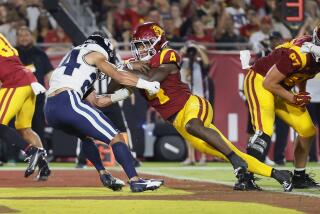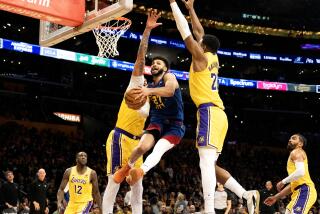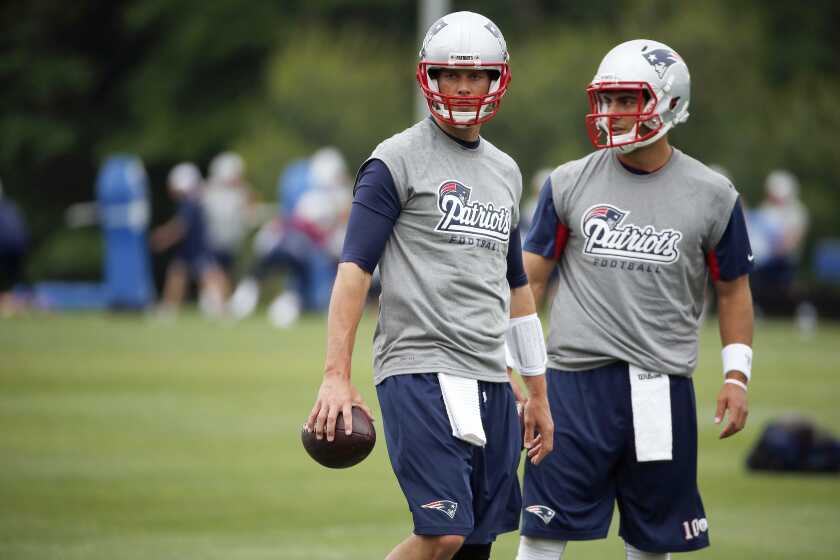Making a Trophy Case
For more than six decades, college football’s immortal award has been accompanied by an eternal question.
Exactly who is that little bronze guy stiff-arming, anyway?
For 21 years, it has appeared to be the West Coast.
This fall, it definitely is Carson Palmer.
The leader in the Heisman Trophy race should be college football’s hottest quarterback directing one of its hottest teams through the sport’s toughest schedule.
But Eastern bias is shoving him to the sidelines.
In the last five games, no quarterback has been better, no running back has had as much impact, no other player has stepped to the front of the Heisman race with such grit and grace.
But to hundreds of the 1,050 voters, he is little more than the guy flickering above them on a muted TV screen as they chow their postgame tri-tip.
Carson Palmer is not discussed by the old-timers sitting at Bobby Bowden’s feet, not examined by the young bards hanging around Mack Brown’s office, not understood by the bundled masses waiting to forgive Joe Paterno’s next referee rant.
Carson Palmer is not touted by an ESPN network that does not televise Pac-10 games, and rarely touches the radar screen of Web site guys who never leave the couch.
And he is not alone.
Since Marcus Allen became the last West Coast player to win one in 1981, the Heisman Trophy has become the most regionally biased and unfair award in sports.
During that time, every other major sport has awarded its top honors to West Coast athletes.
Even the skating-rink-sized NHL is less parochial than a sport whose major award is based not on how you play, but where you play, and what time, and will the Ann Arbor cable company be showing it?
“My shot of winning a Heisman Trophy is so slim, I don’t even think about it,” Palmer said earlier this week. “It’s very, very rare that I would have a chance. That’s just how it works.”
Since 1981, here’s precisely how it has worked:
* Herschel Walker has beaten John Elway.
* Gino Torretta has beaten Marshall Faulk.
* Eric Crouch has beaten Joey Harrington and David Carr.
And so on.
When individual excellence occurs on the West Coast in any other sport, even if Shaquille O’Neal doesn’t sometimes agree, it is generally recognized.
When it occurs out here in college football, it’s Happy Hour in Tuscaloosa and nobody is paying attention.
If you don’t believe me, then listen to college football’s patron saint:
“I have always been very tender on the point that, I think the West Coast guys get screwed,” Keith Jackson said. “I still do.”
*
Ken Dorsey of Miami? Carson Palmer has thrown for nearly 500 more yards than Dorsey, and has a much higher completion percentage.
Willis McGahee of Miami? He wouldn’t even be leading the Pac-10 in rushing.
Brad Banks of Iowa? Palmer has completed 71 more passes and thrown for 477 more yards.
Chris Brown of Colorado? In the Buffaloes’ two losses, he averaged 3.8 yards a carry.
Byron Leftwich of Marshall? He has been injured.
Those are the top Heisman candidates in most polls, yet Palmer has better numbers than any of them.
“And nobody has played a tougher schedule since Germany in World War II,” said college football expert Beano Cook.
Then there’s Jason Gesser of Washington State, Palmer’s West Coast rival. In the last five games, Palmer has thrown for 369 more yards and four more touchdowns.
The biggest number hurting Palmer is the Trojans’ two losses.
But this is not an MVP award, right?
“That’s not how it was designed,” Jackson said. “When it first started, it was for the best player. Because everybody played both ways, it was easy.”
But today?
“Specialization has made it just about impossible to say who is the best player in the country,” Jackson said. “But Carson Palmer is as good as any player I’ve seen.”
On the other side of the country, Cook agreed that Palmer should have a chance.
“If he beats UCLA and has a good game against Notre Dame, he can win it,” Cook said. “I get the impression that voters just don’t want to vote for Dorsey, and they are looking for any reason to vote for somebody else.”
Palmer certainly can win it.
If indeed the Trojans go 10-2 and he plays well against Notre Dame on national television, he should win it.
But will he win it?
Acknowledged Cook, “I don’t think anybody gets up in the morning and says they’re not going to vote for the West Coast guy. But I do think people would rather vote for people closer to home.”
Sighed Jackson, “College athletics are the only endeavor in the world where provincialism is a strength.”
Therefore, to appreciate the Nebraska sea of red, and Florida swamp, and the Columbus High Street party, one must accept that the same boosterism can also taint.
This column may appear to be born of the same boosterism. But those around town know that this space has consistently been tough on Palmer and the rebuilding USC program, even as recently as the loss to Kansas State.
Then, suddenly, the quarterback who wasn’t even touted on his team’s media guide cover began playing like the potential No. 1 draft pick in the nation. And his teammates followed.
Or, as Jackson said, “This hasn’t always been true in times past, but right now, Carson is as good as anybody I’ve seen.”
This isn’t about favoritism. It’s about fairness.
And it would be yet another chapter in a history of Heisman hilarity if Palmer weren’t given a fair chance.
“The record speaks for itself,” said Tom Hansen, Pac-10 commissioner whose league traditionally produces more NFL players than any other. “Looking at the pro rosters, there’s a good deal of evidence that we’ve had great football players out here. That none of them has won a Heisman since 1981, there’s something very dysfunctional in that.”
The problems begin with the actual balloting, 175 voters each in six regional sections, writers and broadcasters and former Heisman winners.
Three of those sections are in the Eastern time zone, only one is in the Pacific time zone.
And, although the identity of the voters is kept quiet, it seems to be based on an old-boy network that has somehow, incredibly, excluded folks such as Chris Dufresne, The Times’ nationally acclaimed college football writer.
If a guy who sees as many games as anybody in the country while working for the nation’s second-largest metropolitan daily newspaper does not vote ... who does?
(Actually, our sports editor, Bill Dwyre, has a vote, but I’m not going there ... )
With so many of those voters on the East Coast, and perhaps many of them out of touch with weekly games, television is now essential for fairness.
Yet the Pac-10 televises its games on a network -- Fox Sports -- that does not reach as many East Coast homes as college football’s most important network.
In fact, one could correlate the disappearance of West Coast Heisman winners with the emergence of ESPN as a Saturday afternoon monster.
The ESPN announcers can make a Heisman candidate with their “College GameDay” patter. Yet they don’t visit the Pac-10 schools and don’t televise Pac-10 games.
“It’s preposterous to think that we are hurt by Fox,” Hansen countered. “We get great national coverage from them.”
Besides, he said, “Every time we talked to ESPN about a contract, they could not offer us good time slots, and therefore not as much income.”
So the Pac-10 is huge in Seattle and San Diego.
But in Atlanta a couple of years ago, the lack of TV exposure led to a typical Heisman bias story.
Several Heisman voters, accompanied by Dufresne, had finished covering an SEC game and were relaxing at an Atlanta hotel bar, watching a late UCLA game featuring Cade McNown.
The Bruins were trailing, and McNown was struggling, when the bar closed at 1 a.m. EST.
By the time the voters had returned to their rooms and prepared for bed, McNown had led the Bruins on an amazing comeback.
But because the room televisions did not pick up the Fox feed -- few hotels do -- the voters never saw it.
Later that fall, McNown was voted the nation’s top quarterback by a couple of organizations but finished third in the Heisman voting behind Ricky Williams and Michael Bishop.
Michael Bishop?
“To some extent, when it comes to the Heisman Trophy, we have to just say we are never a factor and can never get our hopes up,” Hansen said.
All of which has USC Coach Pete Carroll, still relatively new to this funky college stuff, shaking his head.
“Carson Palmer is the best player, playing against the toughest schedule,” he said. “What more do you have to do?”
Four things, actually.
Beat Arizona State. Beat UCLA. Beat Notre Dame.
Then hope folks look up from their deep-fried provincialism long enough to notice.
*
Bill Plaschke can be reached at [email protected].
*
(BEGIN TEXT OF INFOBOX)
Heisman Hopefuls
How USC’s Carson Palmer stacks up
with the best in college football:
*
Statistics for the other leading candidates:
QUARTERBACKS
*--* PLAYER ATT COMP PCT YDS TD INT RATING REC Ken Dorsey, Miami 279 152 54.5 2,265 21 8 141.8 9-0 Byron Leftwich, 334 223 66.8 2,995 19 7 156.7 7-2 Marshall Brad Banks, Iowa 241 146 60.6 2,269 23 4 167.8 10-1 Jason Gesser, 320 190 59.4 2,696 24 8 149.9 9-1 Washington State
*--*
*
RUNNING BACKS
*--* PLAYER CAR YDS AVG TD REC Willis McGahee, Miami 190 1,188 6.3 17 9-0 Chris Brown, Colorado 250 1,617 6.5 17 7-3 Larry Johnson, Penn State 204 1,409 6.9 12 7-3
*--*
More to Read
Go beyond the scoreboard
Get the latest on L.A.'s teams in the daily Sports Report newsletter.
You may occasionally receive promotional content from the Los Angeles Times.











